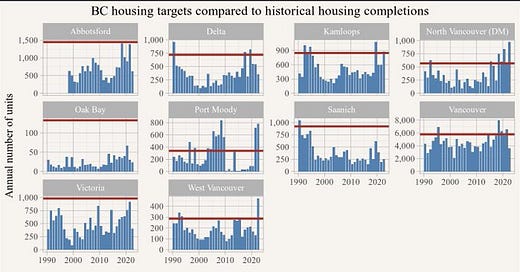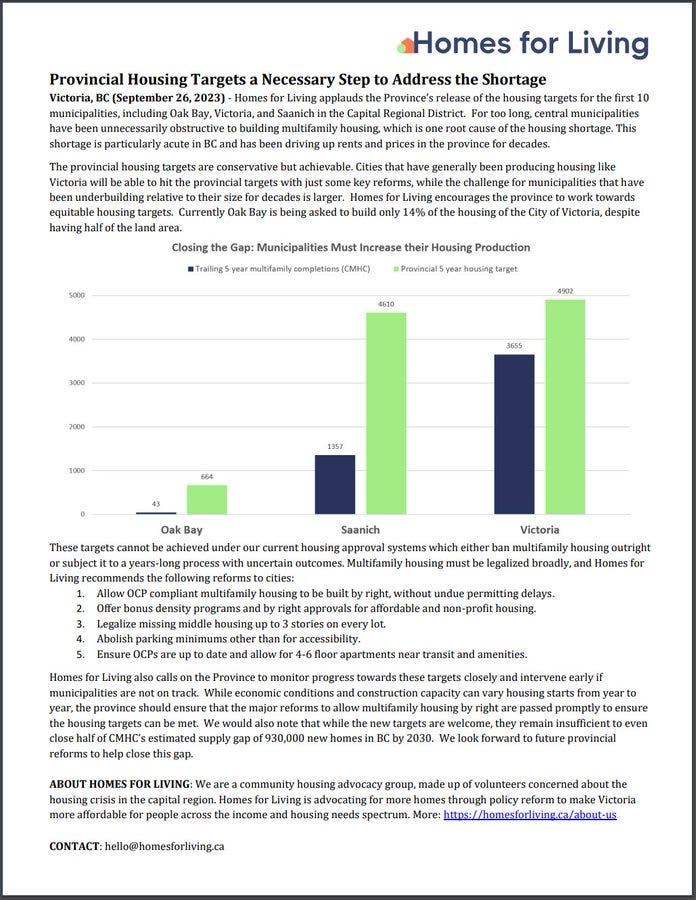BC announces first housing targets
Based on current housing needs rather than political calculation
Yesterday, the BC government announced its first five-year targets for 10 municipalities.
The targets are for housing completions (not just starts), which means that a municipality needs to ramp up its approvals years in advance to be certain to hit the completion targets. There’s a delay from approval until construction begins, and then it takes time to actually complete construction (two years or so for apartments).
The targets are for net housing completions, after subtracting demolitions (around 600-1000 per year in the city of Vancouver).
I was surprised by the target for the city of Vancouver, which doesn’t seem that different from the city’s current rate of homebuilding. Using the gap between price per square foot and construction cost in the city of Vancouver, Jens von Bergmann and Nathan Lauster estimated that there’s a shortfall of about 130,000 homes in the city of Vancouver alone, so I was expecting something a target of more than 10,000 homes per year, not 6,000. (Initially I wondered if the province was setting a target of 6,000 completions on top of business as usual.)
As Lenny Zhou puts it:
Homes for Living Victoria describes the Vancouver Island targets (Victoria, Saanich, Oak Bay) as reasonable.
Methodology for setting targets
So why is the target for the city of Vancouver relatively cautious? My understanding is that the targets aren’t based on political calculation, as you might expect. Rather, the province defined a method to determine housing needs, and the targets are simply calculated using that method.
Hopefully the province will be willing to review and improve the methodology over time, comparing the results to other methods for consistency.
The Province’s estimate is based on a standardized methodology that counts how many units are needed to address the shortage of housing today and to respond to population growth over the next five years. This approach relies on data from publicly available sources, including BC Stats, Statistics Canada and the Canada Mortgage and Housing Corporation.
A. Supply to address extreme core housing need; plus
B. Supply to permanently house people experiencing homelessness; plus
C. Supply to address suppressed household formation; plus
D. Anticipated supply needed over the next five years, plus
E. Adjustment to restore rental supply to a healthy vacancy rate of 3%.
And then there’s details for each component.
Component A: Extreme Core Housing Need
By tenure, this measure quantifies housing needs for households for a select community. Data for 2021 from Statistics Canada and data for 2006-2016 is available through the custom data provided for local government Housing Needs Reports through the Ministry of Housing.
Due to lower rates of core housing need in 2021 due to the impact of Canada Emergency Response Benefit on core and extreme housing needs, calculating an average approach provides a reasonable estimate of extreme core housing need.
Component B: Homelessness
Component B estimates homelessness in the select community. There are data limitations to quantifying homelessness through any method and homelessness levels can vary between communities for a variety of reasons. This approach allocates homelessness proportionally among communities in a region, ensuring that each community works toward creating housing to support this population.
Regional homelessness data as captured by the Integrated Data Project is applied to the select local government based on its proportion of the regional population.
Component C: Suppressed household formation
This methodology adjusts for a higher household formation rate (through adjusting “headship rates”) in a community using a previous baseline year (i.e., 2006) to reduce any suppressed households in 2021. A headship rate is defined as the ratio of the number of households of a primary household maintainer age to the total population of an age group, which indicates the likelihood of household formation in each of the age groups.
Component D: Household growth
A range of household growth is projected using two growth rate scenarios: the Local Growth Rate Scenario and the Regional Growth Rate Scenario. Household growth is projected for 2023 to 2028. The median of the two scenarios informs the anticipated units component of the total housing needs estimate.
Component E: Vacancy rate adjustment
This component accounts for the number of units required to bring the vacancy rate to 3% in communities where the vacancy rate is currently below that level. The calculation for determining the supply needed to account for vacancy rate adjustments uses CMHC vacancy rates in the primary rental market to estimate the number of vacant rental units (across both primary and secondary rental markets).
Below-market rental targets
It looks like the methodology defined by the province simply estimated the number of homes of each type needed. (The estimates seem unreasonably precise - isn’t there a confidence interval?)
For market housing, I think the expectation is pretty simple:
There’s people who want to live and work in the municipality.
There’s other people who want to build market housing for them.
The municipality has to say yes in a timely way.
For below-market housing and for supportive housing, it’s much less clear what the province is expecting the municipality to do. The city of Vancouver provides non-market housing using bonus density and cross-subsidization from market rentals, but I think this is somewhat unusual - non-market housing is usually considered to be provincial jurisdiction.
Perhaps the expectation would be that if someone wants to build non-market housing (whether that’s a non-profit or the province), the municipality shouldn’t stand in the way?
What happens if a municipality fails to meet its targets?
From the backgrounder: a municipality which is falling behind its target completions after six months needs to submit a plan of action.
The Province has issued housing target orders for the first 10 municipalities by ministerial order, which sets out the total minimum number of net new housing units that must be completed each year over a five-year period. Net new means new units that are ready for move in, minus units that were lost through demolition.
Housing targets will be measured after the first six months, then annually by net new units completed and actions taken by the municipality to meet the targets. If the cumulative annual housing target has not been met, the municipality will be required to submit planned actions they will take within two years to meet the target.
If a municipality has not met a target and is not making satisfactory progress toward meeting the housing target, the minister of housing may appoint an adviser and/or issue a directive. The adviser’s role would include reviewing the actions, policies, practices and progress of the municipality toward meeting the target.
More
Press release, including an explanation of the methodology used to set targets.
B.C. government orders 60,000 new homes built in 10 municipalities the next five years. Justin McElroy, CBC.
'Naughty list' mayors wonder where money will come from as B.C. sets housing targets. Katie DeRosa, Vancouver Sun.
B.C. sets housing targets for 10 municipalities. Chuck Chiang, Canadian Press.






